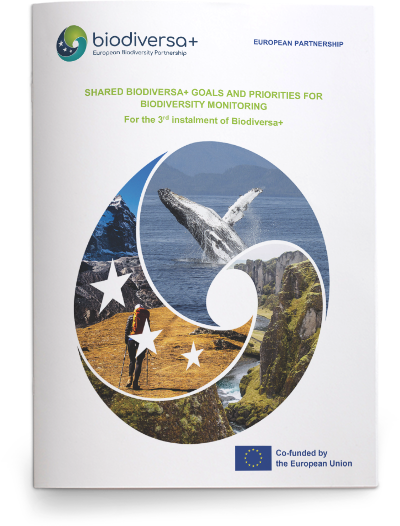“Shared goals and priorities for biodiversity monitoring for the 3rd instalment of Biodiversa+”
Published: March 2025 | DOI: 10.5281/zenodo.15263596
We are pleased to share the second report outlining the shared goals and priorities for biodiversity monitoring within Biodiversa+, setting the direction for the third phase of the partnership from 2025 to 2028.
Biodiversity monitoring plays a critical role in tracking the state and trends of nature, enabling evidence-based conservation and restoration strategies. Within Biodiversa+, monitoring priorities refer to biological components—from genes to ecosystems—that urgently require enhanced capacity, resources, and transnational cooperation. Monitoring is defined as the long-term, standardised and repeated collection of primary data to detect changes, alongside the use of this data to inform indicators. This approach is scale-agnostic and spans terrestrial, freshwater, and marine realms.
Biodiversa+ promotes the use of Essential Biodiversity Variables (EBVs) as a common, interoperable framework for data collection and reporting, and recognises the Driver–Pressure–State–Impact–Response (DPSIR) framework as a tool to address broader socio-ecological dynamics.
Refined priorities for 2025–2028
At its inception, Biodiversa+ identified eight biodiversity monitoring priorities, including Transversal Activities. These were expanded to 12 in the second phase (2023–2025), with Transversal Activities highlighted as a special topic. For the 2025–2028 period, the same 12 priorities and the special topic have been retained, with refined descriptions to enhance clarity and operational guidance:
- Bats: Monitoring all bat species and their habitats.
- Common Species: Monitoring widespread biodiversity using standardised multi-taxa approaches.
- Genetic Composition: Monitoring intraspecific genetic diversity, differentiation, inbreeding, and effective population sizes.
- Habitats: Monitoring terrestrial, freshwater, and marine habitats and ecosystems.
- Insects: Monitoring insect biodiversity, including pollinators.
- Invasive Alien Species (IAS): Detecting and monitoring IAS across realms, including Non-Indigenous Species (NIS) in marine environments.
- Marine Biodiversity: Monitoring biodiversity in coastal and offshore waters, from plankton to marine megafauna and seabirds.
- Protected Areas: Monitoring biodiversity within protected areas, including Natura 2000 sites, across all realms.
- Soil Biodiversity: Monitoring micro-organisms and soil fauna, from bacteria to earthworms and fungi.
- Urban Biodiversity: Monitoring biodiversity in urban, peri-urban, and urban-fluvial environments.
- Wetlands: Monitoring the biodiversity of wetlands, including mires and peatlands.
- Wildlife Diseases: Monitoring biodiversity-related health issues affecting wild animals, livestock, and humans.
- Transversal Activities: Supporting biodiversity monitoring through governance, metrics, information systems, novel technologies, and social sciences.
Selection principles
While areas like general birds and mammals are well-covered by other initiatives, these priorities target urgent gaps where Biodiversa+ can add significant value. Priorities were chosen based on their:
- Contribution to decision-making (aligned with EU Directives and the Kunming-Montreal Global Biodiversity Framework).
- Ability to address monitoring gaps (primary knowledge and secondary issues like harmonisation).
- Transnational perspective and linkage to existing initiatives.
- Emphasis on Biodiversa+’s unique strengths and partnership composition.
The report details each priority’s rationale, policy relevance, and connections to existing initiatives to guide implementation. These priorities guide Biodiversa+ activities, including transnational initiatives, pilot projects, and support for national monitoring efforts.
